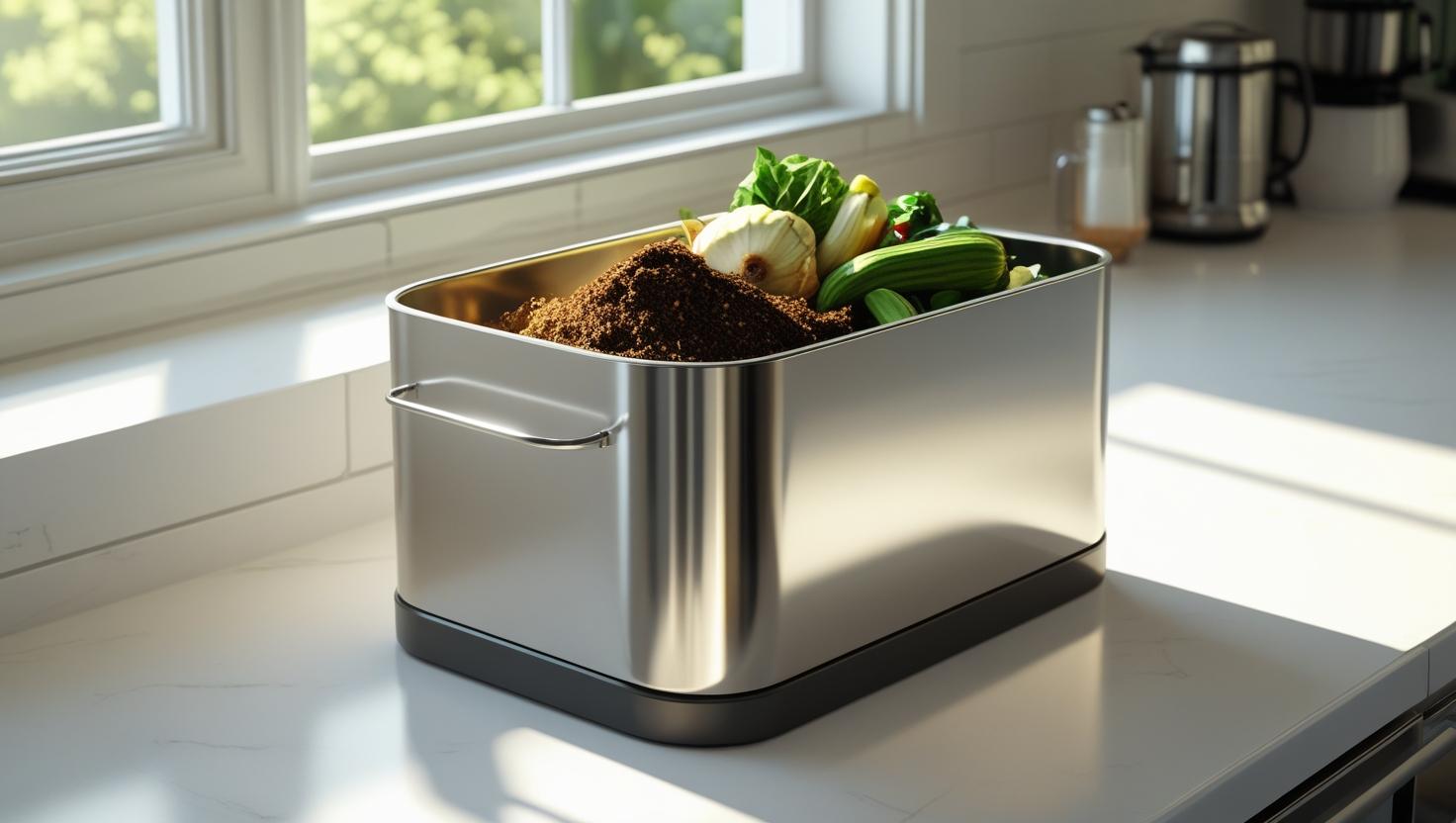Discover the best compost bins for your kitchen counter. Learn how to manage kitchen waste efficiently while keeping your home odor-free.

Why Choose a Compost Bin for Your Kitchen Counter?
Are you looking for an easy, sustainable way to manage your kitchen waste while keeping your home clean and odor-free? A compost bin for your kitchen counter could be the perfect solution! This simple yet effective tool allows you to collect organic waste right from your kitchen and easily transfer it to an outdoor compost pile or bin.
In this article, we’ll explore everything you need to know about compost bins for kitchen counters—from the benefits and features to how to choose the right one and use it efficiently. By the end, you’ll have all the information you need to make an informed decision and start composting in your kitchen today!
What Is a Kitchen Counter Compost Bin?
A kitchen counter compost bin is a small container designed to hold kitchen scraps before they are transferred to an outdoor compost pile or composting bin. These bins are usually placed on or near the kitchen counter for easy access during meal prep. Most counter compost bins come with tight-fitting lids to help contain odors and keep pests out. Some are designed with filters or ventilation holes to promote airflow, which helps the organic matter break down faster.
In short, a kitchen counter compost bin is a convenient, odor-controlled solution for managing food scraps in your home before they are composted outdoors.

The Benefits of Using a Compost Bin on Your Kitchen Counter
Convenience and Accessibility
One of the primary advantages of having a compost bin on your kitchen counter is convenience. By placing the compost bin within easy reach, you can collect food scraps while cooking without having to make multiple trips to the outdoor compost bin. This encourages you to compost more often and makes the process feel effortless.
Odor Control
Many people shy away from composting at home because they fear unpleasant odors. However, modern kitchen counter compost bins are designed with odor control in mind. Many bins come with carbon filters, airtight lids, or specially designed ventilation systems that trap odors and prevent them from escaping. This makes composting a clean and odor-free process, even if you leave the bin on your countertop for several days.
Encouraging Sustainable Practices at Home
Using a kitchen counter compost bin is a small but impactful way to practice sustainability. By composting kitchen waste, you reduce the amount of organic material sent to landfills, which in turn reduces methane emissions—a potent greenhouse gas. It’s an easy, daily habit that helps reduce your carbon footprint and contributes to a greener, more sustainable lifestyle.
Choosing the Right Compost Bin for Your Kitchen Counter
Size and Capacity
When selecting a compost bin for your kitchen counter, it’s important to consider the size and capacity. A bin that’s too small may need to be emptied too frequently, while one that’s too large may take up too much counter space. A good rule of thumb is to choose a bin that holds around 1 to 2 gallons, which is sufficient for most households.
Material Options
Kitchen counter compost bins are available in various materials, including:
- Plastic: Lightweight, durable, and easy to clean. Plastic bins are often more affordable but may not be as eco-friendly as other materials.
- Stainless Steel: Known for its durability and sleek appearance, stainless steel bins are also resistant to rust and corrosion. They are a popular choice for modern kitchens.
- Ceramic: Stylish and attractive, ceramic bins are a great option for those who prioritize aesthetics. However, they can be more fragile than plastic or stainless steel.
- Bamboo: Eco-friendly and sustainable, bamboo compost bins are becoming increasingly popular. They are natural and biodegradable, making them a great choice for environmentally conscious consumers.
Features to Look For
When choosing a compost bin for your kitchen counter, look for these important features:
- Tight-fitting Lid: A lid that seals tightly helps control odors and keeps pests out.
- Ventilation: Some compost bins have small holes or ventilation systems to allow air to flow through, which helps speed up the decomposition process.
- Carbon Filters: Many compost bins include carbon filters, which help neutralize odors and keep the bin smelling fresh.
- Easy-to-Clean Design: A compost bin that’s easy to clean is essential for maintaining hygiene. Look for bins with smooth surfaces and removable parts for easy cleaning.

How to Use a Kitchen Counter Compost Bin Effectively
Step-by-Step Guide to Composting Kitchen Waste
Using a compost bin on your kitchen counter is simple. Here’s a step-by-step guide to get you started:
- Set Up Your Compost Bin: Place your compost bin on your kitchen counter, near your food prep area, so it’s easy to use.
- Collect Scraps: As you cook or prepare food, toss fruit and vegetable scraps, coffee grounds, eggshells, and other compostable materials into the bin.
- Maintain Balance: For the composting process to work effectively, balance your green materials (e.g., food scraps) with brown materials (e.g., paper towels, cardboard). This will help create the right environment for decomposition.
- Empty the Bin Regularly: When the bin fills up, take the scraps outside to your compost pile or bin. You can use a compostable bag or liner for easy disposal.
Best Practices for Kitchen Composting
- Avoid adding meat, dairy, and oily foods to your kitchen compost bin, as these can attract pests and slow down the decomposition process.
- Chop up larger food scraps into smaller pieces to help them break down more quickly.
- Turn your compost regularly to encourage airflow and speed up the decomposition process. Although this step is more relevant for outdoor compost bins, it’s a good practice to mix your scraps occasionally.
Managing Odors and Keeping Your Compost Bin Clean
Effective Odor Control Tips
While most modern compost bins are designed to minimize odors, it’s important to manage them properly to keep your kitchen smelling fresh. Here are a few odor control tips:
- Use Carbon Filters: Many bins come with charcoal filters that absorb and neutralize odors.
- Keep the Lid Closed: Always make sure the bin’s lid is tightly closed to prevent odors from escaping.
- Empty the Bin Regularly: Don’t let scraps sit for too long. Empty the bin every few days to keep odors in check.
Cleaning and Maintenance Routine
To maintain your compost bin and ensure it stays odor-free, clean it regularly:
- Wash the Bin: Empty the compost bin and wash it with warm, soapy water every week or two.
- Disinfect: Occasionally disinfect the bin with a natural cleaner, like vinegar or baking soda, to eliminate bacteria and odors.
- Replace Filters: If your compost bin has a carbon filter, replace it every few months to keep the odors at bay.

What Can and Cannot Go Into a Kitchen Counter Compost Bin?
Compostable Kitchen Scraps
Here are some common kitchen scraps you can compost:
- Fruit and vegetable scraps (peels, cores, stems, etc.)
- Coffee grounds and tea bags (without the paper tag)
- Eggshells
- Paper towels and napkins (if they’re not too greasy)
- Plant trimmings
Items to Avoid
Certain materials should never go into a kitchen compost bin, as they can cause problems in your compost pile:
- Meat, bones, and seafood
- Dairy products (cheese, milk, butter)
- Oily foods and fats
- Processed foods (like pasta, bread with sauce, or chips)
- Non-compostable items (plastic, metal, glass)
How to Transfer Your Kitchen Counter Compost to an Outdoor Bin
Once your kitchen counter compost bin is full, it’s time to transfer the contents to your outdoor compost pile or composting bin. To do this:
- Empty the Bin: Take the food scraps and place them in your outdoor compost system.
- Mix with Existing Compost: If you already have a compost pile, mix the new scraps with the old compost to promote faster decomposition.
- Maintain Your Compost Pile: Keep your compost pile moist and turn it regularly to speed up the breakdown process.
Frequently Asked Questions (FAQs)
Q1: How often should I empty my kitchen compost bin?
It’s best to empty your bin every 3 to 4 days to prevent odors and keep your kitchen tidy.
Q2: Can I compost meat and dairy in my kitchen compost bin?
No, meat and dairy products should not go into your kitchen compost bin as they attract pests and slow down the decomposition process.
Q3: Will my compost bin smell?
A well-maintained compost bin with a tight-fitting lid and carbon filter should not smell. Regularly empty the bin and clean it to prevent odors.
Q4: What size compost bin should I use for my kitchen counter?
A 1-2 gallon compost bin is ideal for most kitchens, offering enough capacity without taking up too much space.
Q5: Can I use a compost bag inside my kitchen compost bin?
Yes, compostable bags are a great way to keep your compost bin clean and make it easier to transfer the scraps outside.
Start Composting on Your Kitchen Counter for a Greener Home
Composting on your kitchen counter is a simple yet effective way to reduce waste and contribute to a healthier, more sustainable environment. By choosing the right compost bin, using it properly, and following best practices for odor control and cleaning, you can make composting a hassle-free habit. Start today and enjoy a cleaner, greener home while doing your part to protect the planet!


